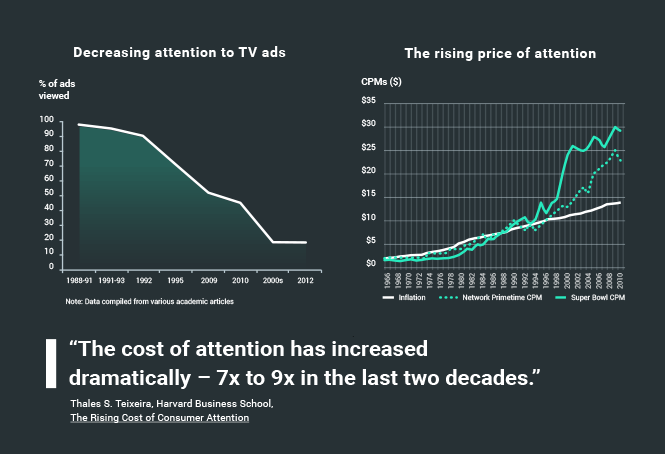Executive Summary
Lacking real-time performance indicators, performance-hungry brand advertisers have settled into a lowest-cost impression mindset. This creates a welcoming environment for ad fraud ($35 billion in 2020) and low impression quality, where only 51% of advertiser spend actually reaches publishers and audiences.
A “broken reach” model distances itself from humans and persuasion for what is cheap. Instead, advertisers should adopt an “attentive reach” model, which defers to human attention as a qualifier of advertising itself.
When orchestrated throughout a campaign, an attentive reach model can achieve significant impact gains and reduce waste as much as 30% through creative quality selection alone. Over time, individual campaigns contribute to valuable attention performance benchmarks to continuously improve advertising planning, flighting and assessment.
Aligning resources to drive attentive reach performance is ultimately a matter of more efficient and effective capital deployment. The CMO must drive the attention mandate, and the CEO and CFO must champion the CMO in prioritizing and driving the mandate across the enterprise.

Max Kalehoff
Vice President of Marketing & Growth
Performance & Brand Advertising Collide
E-commerce has accelerated amidst the pandemic.
The hype has flooded into conventional brands in the CPG (consumer-packaged goods) category and similar categories. For example, beauty goods manufacturer L’Oreal is transforming its business into an e-commerce powerhouse, predicting that e-commerce will comprise 50% of its sales by 2023.
The growth of e-commerce in the CPG sector stimulated a strong desire to evolve brand advertising in ways that emulate performance marketing. This includes real-time decisioning and payment transactions for outcomes like sales, leads or clicks. The path from ad investment to the cash register is immediate and clear, so there remains a natural, growing affinity to these performance outcomes.
Fallacy of 'Broken Reach'
With strong near-term performance signals, reach and targeting remain the core optimization levers for brand advertising campaigns – with a master KPI of cost. The primary performance goal is to hit reach thresholds within a given time window, at a given cost, amidst the complexities of different media platforms. Frequency is a bit of a ‘crapshoot’ when there’s more than one platform. This model is about moving impression tonnage.
The CPM performance model presents a deceitful, short-term lens for advertising decisioning. Left unchecked, the lowest CPM model allows low quality impressions and fraud to thrive.
“According to CHEQ and economist Roberto Cavazos at the University of Baltimore, ad fraud has risen in 2020, costing marketers $35 billion, or 11% of the $333 billion digital advertising industry.
According to ISBA, the supply chain for digital programmatic advertising is so broken that only 51% of advertiser spend makes its way to publishers, and 15% of supply chain costs are entirely unattributable.”
only 51% of advertiser spend makes its way to publishers
Beyond waste and inefficiency, unintended consequences of the lowest-cost CPM model include poor consumer experience and long-term ROI erosion. This resembles not “reach,” but “broken reach.” The broken-reach model considers media impressions a binary checkbox, removing advertising from its fundamental purpose: to expose a brand message to a receptive audience.
All this leaves advertising leaders scratching their heads: which performance indicator can they use to plan and then optimize campaigns in flight for long-term brand goals? Brand advertising needs a real-time compass to drive long-term performance.
Promise of “Attentive Reach”
Attention changes the game. According to Forrester, 80% of CPG marketers are hungry for better customer attention data and 98% of respondents believe that attention metrics would drive value for their organizations.
Attention is an immediate result required for any subsequent advertising outcome, including emotional response, which triggers memory and drives behavior – let alone brand awareness, preference, sales and lifetime value. Attention is a human response, not an algorithmic one, which means investments qualified for attention are qualified for human resonance.
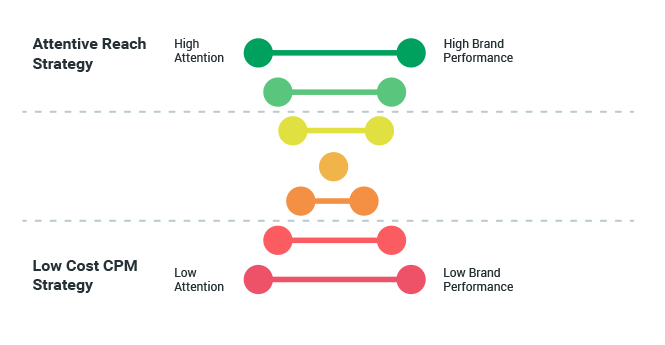
Like viewability, attention is a hygiene factor for all outcomes, and attention is a quantifiable variable. No brand experience is created equal, and attention is a powerful lever to make every dollar, creative asset and media impression count.
Attention alone doesn’t equal success, though nothing equals success without attention. It is time to end “broken reach,” where humans and attention are indifferent, and replace it with “attentive reach,” where humans and attention qualify what is effective advertising.
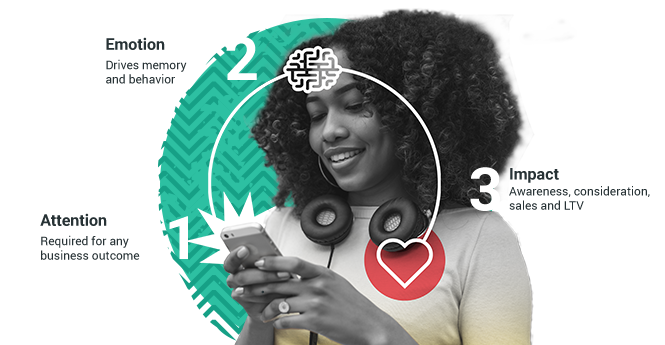
Three Drivers of Attentive Reach
There are three main drivers of attention to manage for in brand advertising campaigns where reach is paramount: creative, audience and context. These are familiar variables for advertisers, and now reconcile against the outcome of attention.
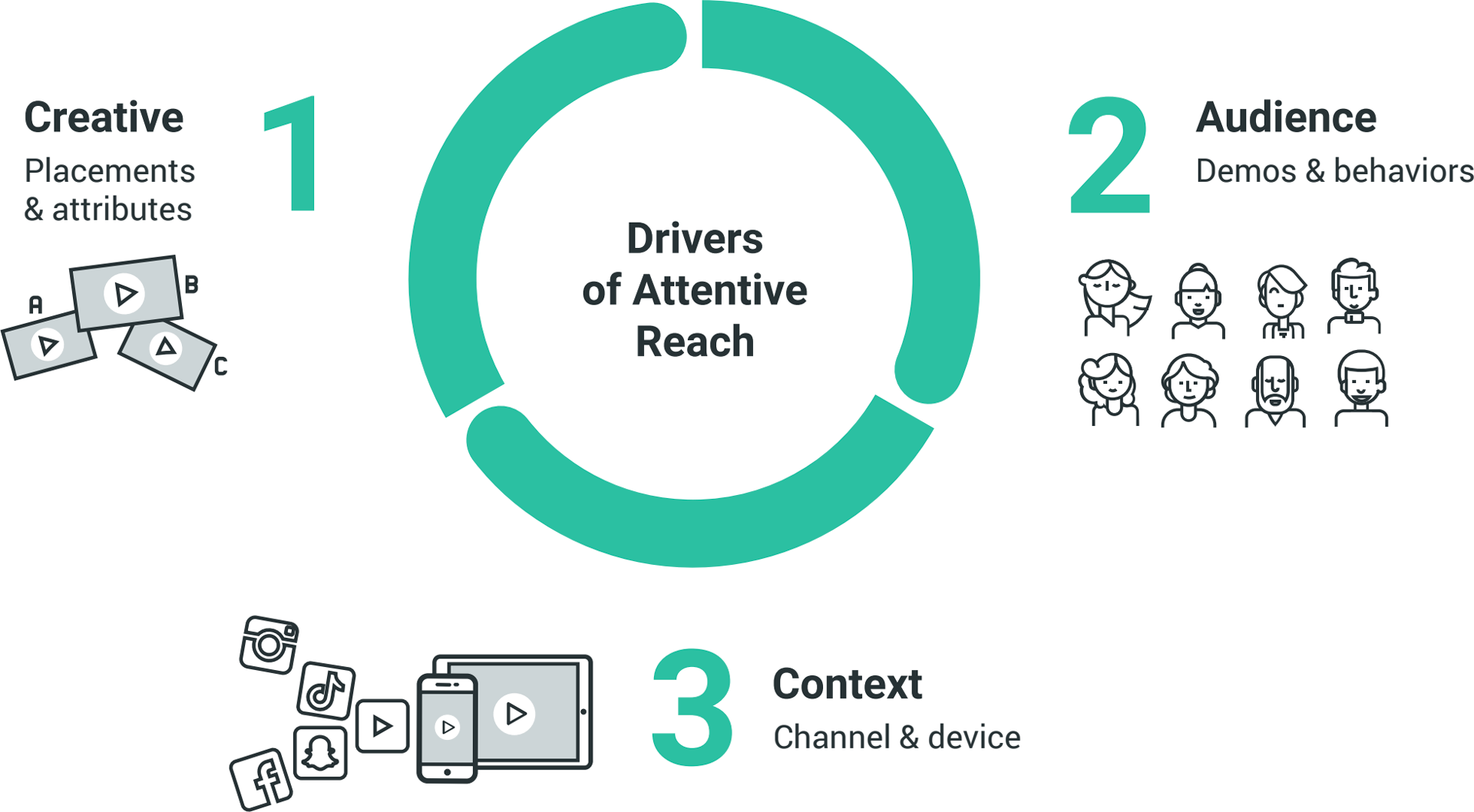
1. Creative: Creative is the most important driver, because of its inherent ability to earn attention and drive emotional response. According to Nielsen NCS, creative is responsible for 48% of sales outcomes in brand advertising campaigns.
Creative is far more influential than any other campaign variable like targeting, reach or frequency. A $10 CPM can quickly turn into an $100 quality CPM if the attention performance of a video ad is low!
2. Audience: The second driver to manage towards attentive reach is audience. Different audience segments will respond differently to different creatives. For example, a loving dog owner may respond with more attention to a pet food video versus someone who isn’t.
3. Context: The third dimension is context, which includes the channels, surrounding content and ad formats that shape the attentiveness of the audiences that publishers sell to advertisers. The Super Bowl may be a premium context for attention because viewers lean into the ads, and most views occur the very first time.
There are three main drivers of attention to manage for in brand advertising campaigns where reach is paramount: creative, audience and context. These are familiar variables for advertisers, and now reconcile against the outcome of attention.
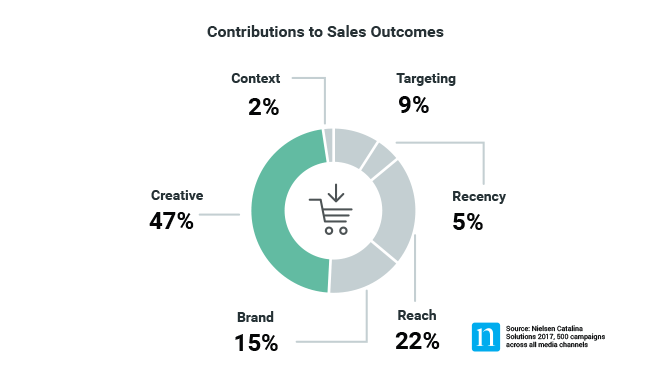
Managing Advertising for Attentive Reach
Every campaign should deliver three fundamental outcomes: 1. brand equity, 2. Sales, and 3. learning. The campaign must perform, ideally hitting goals that drive sales and lifetime value.
Sales outcomes, alone, are short sighted, so the campaign must also contribute learning that informs the next campaign, as well as higher level concerns like product design, customer experience, competitive intelligence and market opportunity.
These campaign outcomes are predicated on a brand’s commitment to a holistic performance data strategy. This paper’s purpose is not to address the ingredients of a sound data strategy. Though we will assume that one embraces key attributes like ingestion and storage of multiple data sources: identification, accessibility, sharing, analysis and enterprise adoption.
The data strategy is critical for orchestrating individual campaign performance, as well as aggregating historical performance for long-term learning.
The Compound Effect of Attention in Advertising
Optimizing attention at key advertising stages drives higher quality exposures at lower cost, resulting in compounding brand impact.
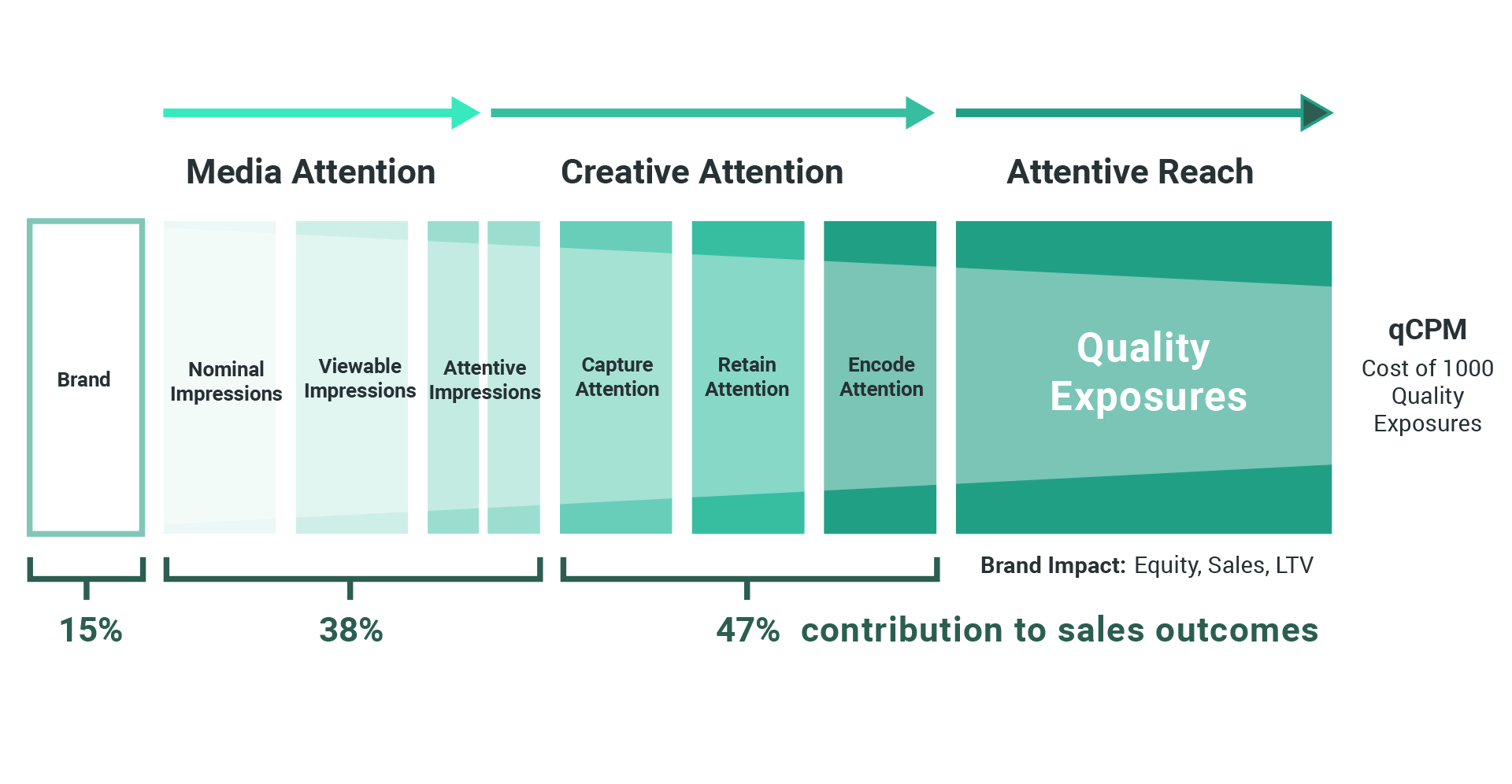
Planning
Creative has the ultimate power to capture and retain attention during media exposures, and to influence the true cost and impact of each media impression.
Advertisers should consider forced-exposure testing every single creative asset for attention performance – before even a single dollar of media is activated. Pre-launch testing techniques, like facial coding, can qualify which ads perform best against attention outcomes.
Testing also provides diagnostics to edit and improve ads for attention and emotional response – both ingredients for influencing memory and behavior.
Pre-campaign testing can also predict creative performance against target audiences and media contexts. This intelligence can inform budgeting and deployment of large portfolios of creative assets.
Determining Creative’s Impact on CPMs
A scalable framework to understand quality CPM (qCPM) using an example of a 6-second ad with a $10 CPM.
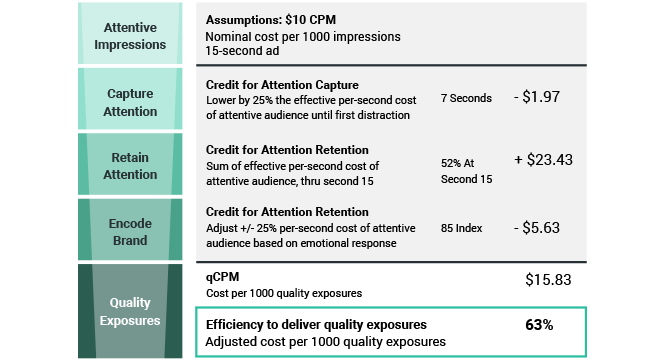
In the media planning phase, advertisers should also address the audience attention quality of platforms and publishers. Viewability – the potential to see an ad – is an accepted MRC baseline of impression hygiene. Though viewability does not equal viewed. That’s why effective CPMs, if attentive viewing is the threshold, vary widely and often counter the face value of viewability.
30% attentive exposure lift achievable through qCPM-based ad selection
The ROI of High-Attention Creative
A Realeyes study on attention quality across 51 CPG video ads, shows how simply reallocating budget away from the low-performing 11 ads to the other 40 with higher attention performance can yield a 30% gain in quality attentive exposures. To learn more, download The High Price of Low Quality Video Advertising.
Planning Media for Attention
In the media planning phase, advertisers should also address the audience attention quality of platforms and publishers. Viewability – the potential to see an ad – is an accepted MRC baseline of impression hygiene. Though viewability does not equal viewed. That’s why effective CPMs, if attentive viewing is the threshold, vary widely and often counter the face value of viewability.
There are emerging tools that measure attention gazing across different media platforms. In absence of such a dedicated planning tool, smart media buyers can build their own planning models using proxies like historical video-completion rates or average time in view, among others.
To conclude, advertisers should incorporate attention when planning creative, context and audience to maximize quality, attentive reach at the lowest cost.
Activation
Advertisers are gaining more options for measuring attention performance during a campaign. Viewability companies offer attention proxies, which are highly useful, though don’t make the full leap to measuring real human response.
It is possible for a video to be in full view for full duration with sound on, and viewability measurement will rightly score that. Though a viewability technology would fail to determine if a person was actually paying attention or exhibiting emotional response to a brand message adjacent the surrounding content.
How often does a viewer switch attention to a mobile phone, a bag of potato chips, or the bathroom, when forced to endure a TV advertising pod? We all (intuitively) know the answer to that.
Viewability and interaction measures also can be gamed, which creates poor user experience. This is where biometric and computer vision solutions are expanding the frontier of attention measurement, in mobile advertising environments, streaming and linear TV.
These systems reveal where attention impact is made in the real world, showing human presence and attention performance for both creative and context, and the interaction between the two. Advertisers can optimize on the fly, in-flight, with live attention signals.
Forced-exposure creative testing also has a role during a campaign, not just in the planning phase. By isolating context, it can deliver high fidelity to drivers of attention performance, where live in-context measurement may fall short. Advertisers should test during the campaign, when existing creatives are edited, and when new ones are released.
Avinash Kaushik, head of strategic analytics, Google, recently said, “We even recommend retesting creative that was in use before COVID-19 to ensure it is still effective and relevant — and that it doesn’t run the risk of striking the wrong note.”
To learn more about attention measurement approaches, download the CMO Guide for Measuring and Managing Attention Outcomes.
Evaluation & Benchmark
Throughout a campaign, advertisers should assemble all of their attention performance data according to their master data strategy.
Post-campaign, advertisers can tap their attention data bank to surface correlations with latent business outcomes such as brand equity studies, sales and lifetime value.
Advertisers can establish best practices and predictive models across creative and media for future campaign planning and optimization cycles.
Over time, each brand advertising campaign will improve the benchmarks, strengthening confidence in near-term attention signals to make better decisions for long-term results.
Attention Performance is a CEO, CFO and CMO Imperative
To operationalize attention in advertising, courageous leaders must overcome common bifurcations of critical advertising functions. Attentive reach performance requires orchestration across creative, audience and context.
The creative, media and data teams control these drivers, and they can achieve attentive reach performance if they work fluidly toward common KPIs with open data sharing. With misaligned KPIs, and operating in silos, they become a collective barrier to success.
Orchestrating is easier for smaller, integrated advertising teams, and more challenging for larger advertising operations. The latter must work harder to overcome cross-functional silos, inertia, complex governance and the inevitable politics.
Regardless, aligning resources to drive attentive reach performance is ultimately a matter of more efficient and effective capital deployment.
Case in Point
In a report from The Attention Council, Sorin Patilinet, Global Marketing Insights Director, Mars Inc., says, “A higher level of attention has a strong relationship with a higher business outcome: sales impact.”
A higher level of attention has a strong relationship with a higher business outcome: sales impact.
He describes that to maximize sales impact, digital creatives they produce get pretested using a mix of attention measurement and time in view. Mars has found that those variables predict sales patterns and allow a descriptive review of the creative when combined with Mars’ other creative guidelines and other emotional measures.
“Our ambition for 2021 is to track attention for every ad developed. We have a strong belief that only by scaling capabilities can you generate meta-learnings that propel you further in your creative excellence journey.”
Contents:
Share this:
